Escape From the Bronx [aka Bronx Warriors 2]
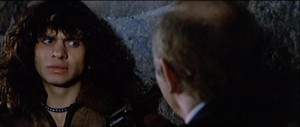 You always know who the villain of any movie is going to be once you see a scale model. This guy envisions some future with all sorts of newfangled property and technology and he’s obviously hired someone to build this tiny replica of what’s on his mind. Now I can see how an architect might be able to put together one of these scale models, but who taught the architect how to do build it? Where do you get parts for miniature versions of tall buildings? Do you have to build the whole thing with Play-Doh? Or is there some sort of Edison equivalent to the scale model, like a magician passing down his tricks to his assistants, to make sure the mini-magic survives?
You always know who the villain of any movie is going to be once you see a scale model. This guy envisions some future with all sorts of newfangled property and technology and he’s obviously hired someone to build this tiny replica of what’s on his mind. Now I can see how an architect might be able to put together one of these scale models, but who taught the architect how to do build it? Where do you get parts for miniature versions of tall buildings? Do you have to build the whole thing with Play-Doh? Or is there some sort of Edison equivalent to the scale model, like a magician passing down his tricks to his assistants, to make sure the mini-magic survives?
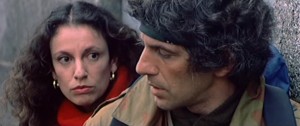 Now the designer of these mini-models either started in or moved onto to building miniatures to be blown up in low-budget movies (which was how James Cameron got his start). There’s no way there was enough work to go around, what with James Bond movies spread out every few years. And what about the guy’s underlings, there’s no way he does it all on his own? Regardless of who ended up where, there’s no doubt that at least a few of these guys were best friends with director Enzo G. Castellari.
Now the designer of these mini-models either started in or moved onto to building miniatures to be blown up in low-budget movies (which was how James Cameron got his start). There’s no way there was enough work to go around, what with James Bond movies spread out every few years. And what about the guy’s underlings, there’s no way he does it all on his own? Regardless of who ended up where, there’s no doubt that at least a few of these guys were best friends with director Enzo G. Castellari.
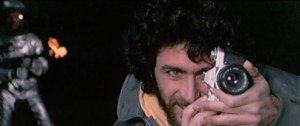 If you watch Castellari’s The New Barbarians or Escape from the Bronx, or virtually any of his films (The Inglorious Bastards, Keoma, The Last Shark) you’ll notice a proliferation of miniatures being blown up and dummies flying around in explosions. What differentiates Escape from the Bronx from those films is that not only do we have the dummies and the miniatures, but we get a villain with a scale model of his vision of the future version* of the Bronx.
If you watch Castellari’s The New Barbarians or Escape from the Bronx, or virtually any of his films (The Inglorious Bastards, Keoma, The Last Shark) you’ll notice a proliferation of miniatures being blown up and dummies flying around in explosions. What differentiates Escape from the Bronx from those films is that not only do we have the dummies and the miniatures, but we get a villain with a scale model of his vision of the future version* of the Bronx.
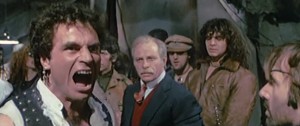 Granted, the title is a bit misleading, as the main villain Henry Clark (played by Castellari’s brother Ennio Girolami) is the one who wants the poor and destitute to leave the Bronx, and the heroes, like Trash (Mark Gregory), Toberlone (Antonio Sabato), and Strike (Giancarlo Prete) are the ones fighting to stay in the Bronx. Does that mean that for once, the villain’s perspective trumps the various heroes? Possibly, especially as Escape from the Bronx is only a semi-sequel to 1990: The Bronx Warriors, which was more about Trash protecting a girl from other gangs in the Bronx, not defending the Bronx as a whole. Besides, 1990: The Bronx Warriors is closer to a rip-off of Walter Hill’s The Warriors, whereas Escape (and The New Barbarians) fit neatly into the heavily occupied Italian sub-genre of Escape from New York/The Road Warrior mash-ups.
Granted, the title is a bit misleading, as the main villain Henry Clark (played by Castellari’s brother Ennio Girolami) is the one who wants the poor and destitute to leave the Bronx, and the heroes, like Trash (Mark Gregory), Toberlone (Antonio Sabato), and Strike (Giancarlo Prete) are the ones fighting to stay in the Bronx. Does that mean that for once, the villain’s perspective trumps the various heroes? Possibly, especially as Escape from the Bronx is only a semi-sequel to 1990: The Bronx Warriors, which was more about Trash protecting a girl from other gangs in the Bronx, not defending the Bronx as a whole. Besides, 1990: The Bronx Warriors is closer to a rip-off of Walter Hill’s The Warriors, whereas Escape (and The New Barbarians) fit neatly into the heavily occupied Italian sub-genre of Escape from New York/The Road Warrior mash-ups.
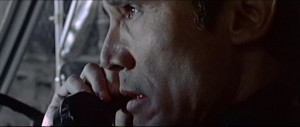 Other than the character of Trash (still outfitted like RamBimbo, but slightly less effeminate this time, if only for his “I’m worse than anybody” dialogue). Escape doesn’t really retain much from Bronx Warriors, and is more of a straight-ahead shoot-‘em-up action movie. Castellari agreed with that statement as he said of Warriors, Barbarians, and Escape that “I directed the first one and played director on the other two.” That totally explains why Escape from the Bronx is so much more fun that Bronx Warriors, embracing the ludicrous whenever possible.
Other than the character of Trash (still outfitted like RamBimbo, but slightly less effeminate this time, if only for his “I’m worse than anybody” dialogue). Escape doesn’t really retain much from Bronx Warriors, and is more of a straight-ahead shoot-‘em-up action movie. Castellari agreed with that statement as he said of Warriors, Barbarians, and Escape that “I directed the first one and played director on the other two.” That totally explains why Escape from the Bronx is so much more fun that Bronx Warriors, embracing the ludicrous whenever possible.
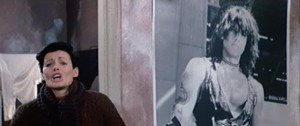 For example; why are all handguns in Escape powerful enough to blow up helicopters in one shot? Why is co-villian Henry Silva so upset about sugar in his drink? [“No sugar! It makes me crazy!”] Why do the mostly faceless troops that try to clear out the Bronx arrive in what looks to be ice cream trucks, only missing the decals? Why do Trash’s parents have a cardboard cutout of Trash in their home? Is that a little self-aware joke on Castellari’s part that his parents are aware their son was in the previous film too? Why is Toberlone outfitted like a pirate, complete with the “puffy shirt” from Seinfeld?
For example; why are all handguns in Escape powerful enough to blow up helicopters in one shot? Why is co-villian Henry Silva so upset about sugar in his drink? [“No sugar! It makes me crazy!”] Why do the mostly faceless troops that try to clear out the Bronx arrive in what looks to be ice cream trucks, only missing the decals? Why do Trash’s parents have a cardboard cutout of Trash in their home? Is that a little self-aware joke on Castellari’s part that his parents are aware their son was in the previous film too? Why is Toberlone outfitted like a pirate, complete with the “puffy shirt” from Seinfeld?
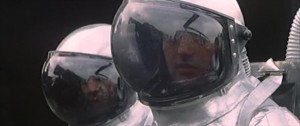 Of course, there are hundreds of other details that reveal the sense of fun on the set, but what’s unique about Castellari’s films (other than the rampant homoeroticism) is that he’s actually a very accomplished action director. There are several hundred people killed in Escape from the Bronx, but it’s never boring, as there’s a lot of variety in the way people die (flamethrower, explosion, gunshot, tripwire, etc.), and the camerawork is excellent**, with a superb sense of space and use of the 2.35 frame, for such an obviously low-budget film.
Of course, there are hundreds of other details that reveal the sense of fun on the set, but what’s unique about Castellari’s films (other than the rampant homoeroticism) is that he’s actually a very accomplished action director. There are several hundred people killed in Escape from the Bronx, but it’s never boring, as there’s a lot of variety in the way people die (flamethrower, explosion, gunshot, tripwire, etc.), and the camerawork is excellent**, with a superb sense of space and use of the 2.35 frame, for such an obviously low-budget film.
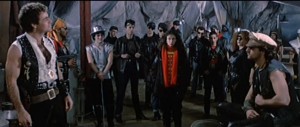 There are several extraordinary tracking shots in the film, the best being in a kidnapping scene where the camera moves past a line of cops, unaware of Trash and Strike hiding in the broken-down structures just behind them. That ambitious sequence highlights the true merits of the film, the delving into political corruption (such as the way the cops deal with the Jennifer Beals-like female reporter***) and the location shooting in NY. It would have been very easy to fake the New York stuff (just like Michael Winner did with Death Wish III, which has a similar view of the Bronx), especially as the many sewer chases are clearly shot somewhere else (Italy), but it lends authenticity to the film. It’s like Castellari was making a real movie**** that didn’t have terrible dialogue and dubbing, and wanted to make sure he was involved in a classy production. Maybe that’s why he has Clark, in one of his many escape attempts, dancing around like a ballerina, as he checks to see if the coast is clear. Or maybe that was just an artistic flourish that Castellari’s brother thought would be appropriate. Or campy. Or both.
There are several extraordinary tracking shots in the film, the best being in a kidnapping scene where the camera moves past a line of cops, unaware of Trash and Strike hiding in the broken-down structures just behind them. That ambitious sequence highlights the true merits of the film, the delving into political corruption (such as the way the cops deal with the Jennifer Beals-like female reporter***) and the location shooting in NY. It would have been very easy to fake the New York stuff (just like Michael Winner did with Death Wish III, which has a similar view of the Bronx), especially as the many sewer chases are clearly shot somewhere else (Italy), but it lends authenticity to the film. It’s like Castellari was making a real movie**** that didn’t have terrible dialogue and dubbing, and wanted to make sure he was involved in a classy production. Maybe that’s why he has Clark, in one of his many escape attempts, dancing around like a ballerina, as he checks to see if the coast is clear. Or maybe that was just an artistic flourish that Castellari’s brother thought would be appropriate. Or campy. Or both.
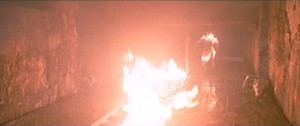 * One of the many, many similarities Robocop has to Escape from the Bronx.
* One of the many, many similarities Robocop has to Escape from the Bronx.
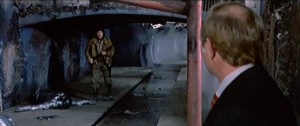 ** Escape from the Bronx was shot by Blasco Giurato, who also shot Cinema Paradiso.
** Escape from the Bronx was shot by Blasco Giurato, who also shot Cinema Paradiso.
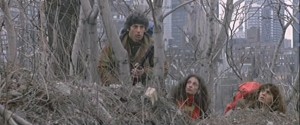 *** Her highlight has to be when she refers to Silva as a “hiyad killah.”
*** Her highlight has to be when she refers to Silva as a “hiyad killah.”
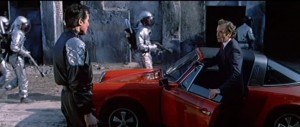 **** Even the standard Italian exploitation J&B product placement is [relatively] subtle.
**** Even the standard Italian exploitation J&B product placement is [relatively] subtle.



